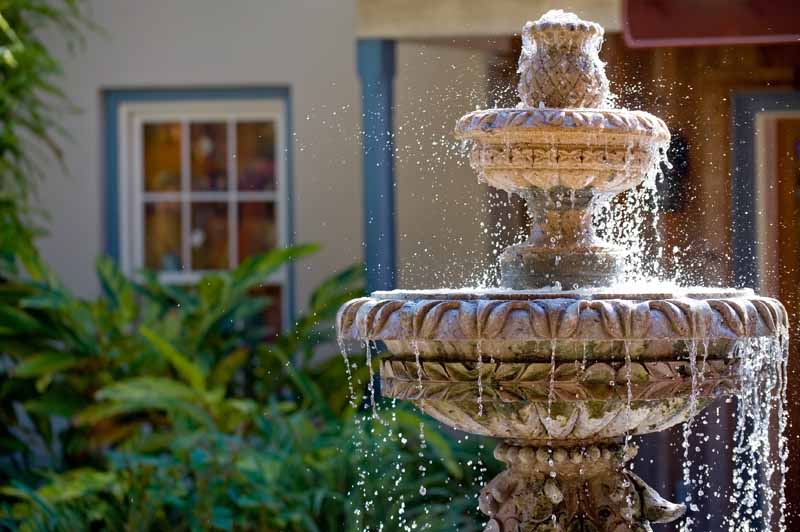As the days begin to get longer and warmer, we tend to spend more time outdoors, so now it’s time to retrieve the beautiful water fountain. A fountain transforms an outdoor space into a relaxing tranquil environment and enhances the aesthetic appeal of your home, giving it a more value.

It’s crucial to follow a few specific steps to ensure that you make the most of your water feature this spring and summer season. Also, in addition to ensuring that your fountain runs efficiently, you will also need to clean the pump. The below steps include the regular maintenance needed to help prolong the life of your pond fountain.
Steps for a fountains spring clean up
Step 1: Retrieving the fountain
It’s necessary to keep your fountain covered or stored away during the harsh winter months for protection from freezing weather conditions. The water is emptied from the fountain to prevent it from freezing and cracking any parts. Then, the fountain is cleaned and stored where it will stay dry until the winter ends. Now is a good time to inspect the fountain for any cracks or damage so that you can seal any cracks or small holes with silicone sealing compound and allow ample time for drying before you proceed.
Step 2: Check the condition of pump
Now that your fountain is ready for action, it’s time to install the pump. Typically, fountains have a reservoir housing or space where the pump connects to up-pipe or tubing. Install the pump before connecting to a power source. Consider adding LED pond lighting in white or color changing to enhance the look of your water feature. This will significantly improve the look of your fountain at night from many angles.
Solar pumps for ponds are exposed to harsh weather, hard water, wildlife, and debris from grass, dirt, and leaves. All of this causes wear and tear on the pump’s impeller in your fountain. So regular cleaning is necessary to help extend the life of your pump. If you notice significant problems that may affect the performance of your fountain, consider replacing it with a new pump. There are many pump options available including solar pump kits online. Be mindful of correctly sizing to ensure you select one that is the best fit for your water feature, and we have charts for that.
Step 3: Clean the fountain
Your fountain may have collected dust during storage. Clean out all the bowls, tiers, and other parts of your fountain as part of the spring tune-up, and let it dry. Smaller fountains could be cleaned in a large sink, and for larger fountains you can use a bucket of water or hose it down. Scrub the fountain with a brush until all algae build-up has been removed. Then, rinse and wipe down with a clean rag or let it air dry before installing the clean pump.
Step 4: Check the fountain for leaks
The next step is filling the fountain with a little water, and to prevent leaking, don’t add too much water and remove some water if needed. If you notice leaks, turn off the fountain, drain it, and dry to check for any pinhole leaks or cracks. It is so much easier to detect the source of the leaks when the fountain is dry. If you find a leak, seal cracks or pinholes with a silicone compound and allow the recommended drying period before running the fountain again.
Step 5: Troubleshooting any issues
Now that you have filled your fountain and inspected for leaks, look out for signs of other potential issues. For example, maybe the pump is not functioning as expected. Make sure to unplug it and do a maintenance check by opening the pump cover to check for any debris on the impeller or build-up of algae on the internal parts. Carefully clean-out the impeller with warm water and brush with soft bristles. Now you can reinstall the pump and turn on the fountain again. It should be working as expected. For further issues, you may need to call a professional technician or electrician to resolve the problem.
Step 6: Add algae prevention solutions
After your fountain has been filled and you have your pump running just right, make sure to add some algae prevention solutions. You also should consider including some white scale control solutions to prevent that build-up in the fountain. Make sure to follow the directions on the package and add the appropriate amounts to keep your fountain clean and lasting longer. The right products will make the job easier and should be safe and non toxic.
It is necessary to follow all of these solutions, in order to make your fountain completely ready for the warm seasons.
What’s the bottom line?
With spring and summer at our doorstep, now is the perfect time to do the spring time maintenance for your
water fountains for ponds and lakes. You will now be able to look forward to enjoying the pleasant sound of your
lake water fountains. Just follow the steps above to ensure that your water feature runs efficiently and meets your expectations. Just remember to prolong the life of your fountain, perform regular maintenance, and replace the pump when necessary. That will prevent algae growth and you will get years of enjoyment.